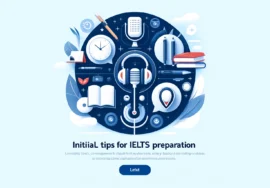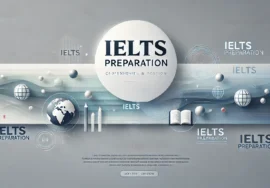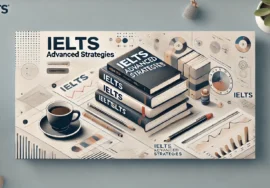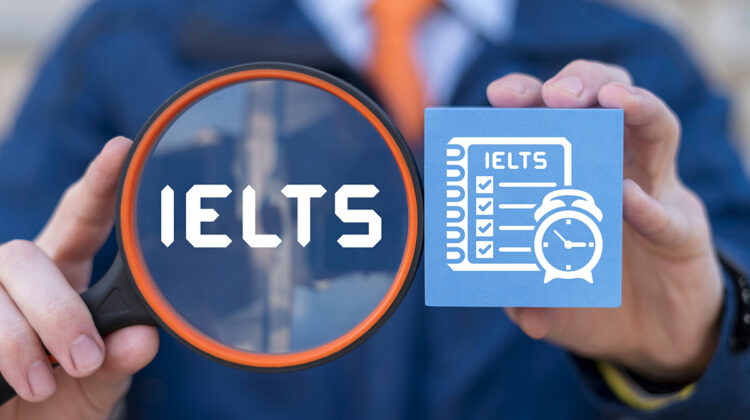
Understanding the IELTS Exam Structure
Discover the complete structure of the IELTS exam, including differences between Academic and General IELTS, scoring system, breakdown of sections, common misconceptions, and tips to improve your performance. Prepare efficiently and achieve a high band score with expert strategies and insights.
Understanding the IELTS Exam Structure
Introduction
The International English Language Testing System (IELTS) is a widely recognized English proficiency exam used for study, work, and migration purposes. Understanding the structure of the test is crucial for effective preparation and achieving a high score. This guide will help you grasp the key differences between the Academic and General Training versions, the scoring system, the breakdown of each section, common misconceptions, and the impact of scoring criteria on test performance.
1. Differences Between Academic and General IELTS
The IELTS exam is available in two versions: Academic and General Training.

While both versions assess English proficiency across four key skills—Listening, Reading, Writing, and Speaking—they differ in terms of content, difficulty level, and purpose.
IELTS Academic
The Academic IELTS is intended for individuals who wish to pursue higher education or professional registration in English-speaking countries. The test focuses on language skills relevant to academic settings.
- Reading Section: Passages are taken from academic journals, books, and research papers, requiring strong comprehension skills.
- Writing Section: Task 1 requires candidates to describe data (graphs, charts, maps, or processes), while Task 2 involves writing an argumentative or discursive essay.
- Speaking & Listening Sections: The format is identical to the General Training version.
IELTS General Training
The General Training IELTS is designed for those migrating to an English-speaking country or applying for work experience or training programs.
- Reading Section: Passages are sourced from advertisements, manuals, newspapers, and everyday documents. The texts are simpler compared to the Academic version.
- Writing Section: Task 1 involves writing a letter (formal, semi-formal, or informal), while Task 2 consists of an essay similar to the Academic test but generally less formal.
- Speaking & Listening Sections: The same as in the Academic version.
💡 Key Takeaway: Choose the test type that aligns with your goals. If applying for university or professional certification, opt for the Academic test. If moving abroad for work or immigration, the General Training test is appropriate.
2. How the Test is Scored
IELTS uses a band score system ranging from 0 to 9, with half-band increments (e.g., 6.5, 7.0, 7.5). Each section—Listening, Reading, Writing, and Speaking—is scored separately, and the overall band score is the average of these four sections.
Score Descriptions
- Band 9 – Expert user (fully operational command of English)
- Band 8 – Very good user (occasional inaccuracies, but highly proficient)
- Band 7 – Good user (occasional errors, but effective communication)
- Band 6 – Competent user (understands main ideas but has some mistakes)
- Band 5 – Modest user (basic communication skills with frequent errors)
- Band 4 and below – Limited understanding of English
💡 Tip: Most universities require a minimum of 6.5 or 7.0, while immigration authorities may require 6.0 or higher depending on the country.
3. Breakdown of Each Section

Listening (30 minutes, 40 questions)
- Format: 4 recorded conversations or monologues
- Question Types: Multiple choice, matching, form completion, short-answer questions
- Common Challenges: Accents, paraphrasing, and following a fast-paced conversation
- Preparation Tips:
- Listen to various English accents (British, American, Australian, etc.).
- Practice taking notes while listening.
- Focus on synonyms and paraphrased information.
Reading (60 minutes, 40 questions)
- Format: 3 long passages (Academic) or 3 shorter sections (General)
- Question Types: True/False/Not Given, matching headings, summary completion
- Common Challenges: Time management and dealing with complex vocabulary
- Preparation Tips:
- Improve reading speed by practicing with newspapers and journals.
- Learn skimming and scanning techniques.
- Understand the difference between True/False/Not Given and Yes/No/Not Given questions.
Writing (60 minutes, 2 tasks)
- Task 1:
- Academic: Describe a graph, chart, table, or process.
- General Training: Write a letter (formal, semi-formal, or informal).
- Task 2:
- Write a 250-word essay discussing a given topic.
- Common Challenges: Grammar accuracy, coherence, and idea organization
- Preparation Tips:
- Practice structuring essays with clear introductions, body paragraphs, and conclusions.
- Use linking words and phrases (e.g., however, therefore, in contrast).
- Avoid informal language in the Academic version.
Speaking (11–14 minutes, 3 parts)
- Part 1: General introduction and personal questions
- Part 2: A cue card task (1-minute preparation, 2-minute speech)
- Part 3: Discussion on abstract topics
- Common Challenges: Nervousness, running out of ideas, pronunciation issues
- Preparation Tips:
- Record yourself speaking and analyze pronunciation.
- Use fillers naturally (e.g., “Well, that’s an interesting question…”).
- Develop the habit of expanding answers instead of giving short responses.
4. Common Misconceptions About the IELTS Format

❌ “The harder words I use, the higher my score.”
✅ Using complex vocabulary incorrectly can lower your score. Clarity is more important.
❌ “If I don’t understand a question, I should skip it.”
✅ Always attempt an answer. In Listening and Reading, never leave blank spaces.
❌ “Speaking fluently means speaking fast.”
✅ Fluency is about coherence and confidence, not speed.
❌ “IELTS is an intelligence test.”
✅ IELTS assesses language skills, not intelligence. Anyone can improve with practice.
5. How Scoring Criteria Impact Test Performance
IELTS examiners assess your performance based on clear criteria:
Writing & Speaking Criteria:
- Coherence & Cohesion: Logical structure and smooth flow of ideas
- Lexical Resource: Range and accuracy of vocabulary
- Grammar Accuracy & Range: Correct use of sentence structures
- Pronunciation (Speaking): Clarity and natural stress patterns
💡 Tip: Study IELTS band descriptors to understand what examiners look for.
6. Time Management Strategies for IELTS
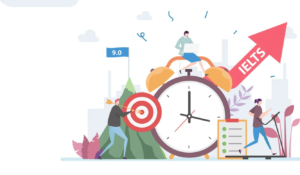
Effective time management is one of the biggest challenges IELTS candidates face. Since the exam is strictly timed, developing strategies to maximize efficiency can significantly improve performance.
Listening Section: Managing Limited Time
- Read the questions before the recording starts to anticipate answers.
- Pay attention to keywords that indicate important information.
- If you miss an answer, move on—don’t let one question affect the rest of your test.
Reading Section: Avoiding Time Traps
- Skim the text first to understand the main idea, then scan for specific details.
- Don’t spend too much time on one question—if unsure, make an educated guess and move forward.
- Use underline and highlight techniques to locate answers quickly.
Writing Section: Structuring Your Time Wisely
- Spend no more than 20 minutes on Task 1 and 40 minutes on Task 2, as Task 2 carries more weight.
- Plan your essay before writing—structure it with clear introduction, body paragraphs, and conclusion.
- Keep the last 5 minutes for proofreading and correcting errors.
Speaking Section: Thinking Quickly on Your Feet
- Use fillers (e.g., “That’s an interesting question…”) if you need time to think.
- Practice speaking about common IELTS topics to build confidence and fluency.
- Avoid long pauses—if stuck, rephrase your idea or add an example.
7. Essential Vocabulary and Grammar for IELTS Success
A strong command of vocabulary and grammar is key to scoring well on all sections of the IELTS exam.
High-Impact Vocabulary for IELTS
- For Writing Task 2 & Speaking:
- Opinion: I strongly believe, it is widely acknowledged that…
- Contrasting ideas: However, on the other hand, in contrast…
- Giving examples: For instance, for example, such as…
- Summarizing: In conclusion, to summarize, in a nutshell…
- For Reading & Listening:
- Synonyms and paraphrasing help in understanding question wording.
- Recognizing common IELTS vocabulary (e.g., trend, fluctuate, significant, sustainable) improves comprehension.
Common Grammar Mistakes and How to Fix Them
- Tense consistency: Avoid switching between past, present, and future without reason.
- Subject-verb agreement: He go to school ❌ → He goes to school ✅
- Using complex sentences: Improve score by linking ideas with relative clauses (e.g., The book that I read was fascinating.)
- Avoiding redundancy: Don’t repeat the same words—use synonyms instead.
8. The Importance of Practice Tests and Mock Exams

Why Practice Tests Matter
- They simulate real test conditions, helping you build endurance.
- Repeated exposure to test formats makes you more familiar with question types and time constraints.
- They help identify weak areas so you can focus on improvement.
How to Use Practice Tests Effectively
- Take full-length tests under exam conditions (timed, no breaks).
- Analyze mistakes to understand where you lost marks.
- Compare your answers with model responses to learn proper structure and vocabulary usage.
💡 Tip: Use official IELTS practice materials from Cambridge IELTS books or the British Council website for the most accurate test simulations.
Conclusion
Understanding the IELTS exam structure is essential for strategic preparation. Knowing the differences between Academic and General Training, how scoring works, and the breakdown of each section allows candidates to focus on key areas of improvement. By avoiding common misconceptions and aligning preparation with scoring criteria, test-takers can maximize their chances of achieving a high score.
🔹 Next Step: Practice with real IELTS materials, take timed mock tests, and refine your skills based on examiner feedback.




